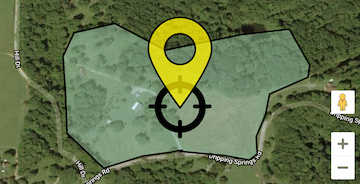Rye-Secale cereale

By Kent Kammermeyer, Senior Wildlife Biologist
Rye is grown in every state in the United States, often when conditions are unfavorable for wheat including tough erosion control scenarios. It is the most popular of the small grains for cattle forage and is the most cold tolerant cereal grain and wildlife planting in the whole country! Rye is more cold tolerant than oats or wheat and also tolerates low fertility and acid soil more than any other small grain. Consequently, rye can be grown in a wider range of environmental conditions than any other small grain. Do not confuse cereal rye (rye grain) with annual or perennial ryegrass, they are totally different plants!
Deer eat the tender nutritious (12-25% protein) foliage in fall, winter and early spring. Of the three major small grains, however, most deer managers would rank rye as third in preference or palatability to oats and wheat. This certainly varies by region, soil fertility and other factors.
Less than 50% of the rye grown in the U.S. is harvested for grain, with the remainder functioning as pasture, hay or as a cover or green manure crop. In addition to contributing organic matter, rye reduces soil erosion and enhances water penetration and retention. Furthermore, some evidence suggests that rye could be exploited for weed control since residues of fall-planted, spring-killed rye reduces total weed biomass by 60% to 95% when compared to controls with no residue. Rye residues modify the physical and chemical environment of the soil during seed germination and plant growth.
Originating in Iraq, Turkey, and Europe, rye is one of the cool season annual bunch grasses that grow two to four feet tall, depending on variety, grazing pressure, and fertility. Seed heads are spikes and leaf sheaths are hairy. Leaf color is more blue-green and leaves are less erect than the other small grains.
Rye is usually planted in September in the North or October in the South. Spring-planted rye should be planted as early as possible (February in the south and as soon as thaw in the north). If planted alone, 90 to 120 lbs/acre is recommended. Planted in mixtures, no more than 60 lbs/acre (one bushel/acre) should be broadcast. Drill rates would be roughly half of the above broadcast rate. Personally, I would never really consider planting rye alone for deer with one possible exception. When it is too late or too cold to plant anything else especially where erosion is an issue, rye serves as an ideal late fall/early spring season cover crop that will germinate and grow in colder, poorer, more acidic soil than any other plant. Under these conditions, it will feed deer and also hold the world together. Otherwise, plant rye in a mix with one or more legumes such as arrowleaf clover (10 lbs/acre, South), crimson clover (10 lbs/acre, South), red clover (10lbs/acre, North or South), white clover (8 lbs/acre, North or South), Austrian winter peas (25 lb/acre, North or South) or birdsfoot trefoil (10 lbs/acre, North). Rye is also very compatible with wheat (30 lbs of each per acre) plus any of the above legumes. My favorite mix is rye (30 lbs/acre), wheat (30lbs/acre), Durana white clover (5 lbs/acre) and Redland Max or Cinnamon Plus red clover (7 lbs/acre). Besides adding palatability, production and protein to the mix, the legumes make perfect companion plants for the rye by fixing nitrogen in the soil (some of which is available for use by the rye). On the flip side, the rye acts as a nurse crop for the legumes for the first month or more after planting by producing vigorous early growth which takes the brunt of the early deer grazing pressure while the legumes develop a root system. It also protects legumes by providing partial shade protecting young sensitive seedlings from hot sun and drought. Rye will often reseed on its own when mowed in August and produce a second year crop mixed with whatever legume it was planted with. I repeat, do not use more than 60 lbs/acre of rye in any rye/legume mix.
Like all other small grains, rye will achieve greatest forage and seed production when soil is limed to raise pH above 6.0, preferably to 6.5. A complete fertilizer applied according to soil test at planting (example: 300 lbs19-19-19) is highly recommended whether planted alone or in a mix.
Fewer diseases attack rye than the other cereal grains. Rye is attacked by the same insects that attack other small grains but serious crop losses are not common. Varieties with high forage production can produce about 3 tons/acre (6,000 lbs) forage (dry weight) and 60-80 bushels per acre of grain if best management practices are followed. These include using a higher seeding rate for forage production and sowing the crop early (for deeper roots and greater ability to use soil moisture). If grazing production to ease the cool season stress period is your goal, apply additional nitrogen (100 lbs/acre 46-0-0) in late fall and late winter. Do not apply the top dressing if you have planted the legume mix! The key to getting good rye forage yields is selecting a variety that fits your situation and operation. Do not plant "combine run" rye, which is not inspected and can contain several species of noxious weeds that you will end up fighting for years to come!
Pennington Field Notes
There are dozens of rye varieties planted all across the U.S. Many have been bred for forage production (these are probably the most appropriate for deer), others for seed production. Good forage varieties include Pennington's own Wintergrazer 70, a high yielding forage rye that finished among top producers at University research experiment stations in Georgia and Texas. At one station in Georgia, Wintergrazer 70 produced 7,974 lbs/acre forage, that's nearly 4 tons! Wintergrazer 70 is an important component of several Rackmaster mixtures.Check with your local Agricultural Extension Agent for forage varieties best adapted to your area.
